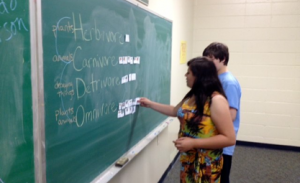Our oldest group of students are gaining a strong grasp of academic material. The Osprey group enrolls 6th through 8th graders. These students are challenged to understand the world around them as a series of microcosms that exist within macrocosms. A summary of a Science class that also features Nature Writers and Journaling is featured in this post.
For our lesson today, we reviewed the pond ecology and pyramids discussed in the last lesson and then also learned about the layers of the pond that support various kinds of life. We diagramed what lives in which layer before heading out to observe the pond with the Delaware Nature Society representative. At the pond we used nets to collect specimens for identification. Students used field sheets to look up the creatures they netted together.
Students were asked to write in their journal in the beginning of class following the mindful opening routine using a quote on which they may reflect. Today’s quote:
Of the infinite variety of fruits which spring from the bosom of the earth, the trees of the wood are the greatest in dignity. ~ Susan Fenimore Cooper
Students were also asked to journal again at the end of class ofter the actual pond study exercise.
The class created an ecology pyramid outline for the pond identifying the food chain trophic levels observed at the pond at Walnut Grove Coop.
Students were asked to consider the impact to the pond if it were to double in size. Would new life join the habitat? Would the temperature of the water change? How might the existing life be impacted?
Writings from Susan Fennimore Cooper were shared in class.
Students were introduced to the Pond “parts” below. Students joined a guest instructor as well as their regular instructor to identify these parts at our pond.
Surface Film: The surface film is a thin, strong layer at the surface of the pond. Many tiny animals live on the film. Water striders, for example, can walk on the film, and pond snails can glide upside down on it. Some plants, especially duckweed and lily pads, float on the film. The surface film is also very important to aquatic insects, which use it to metamorphosize (change) from the nymph (juvenile) stage to the adult stage.
Bottom: The pond’s bottom is usually made of mud. Many aqatic insects, crayfish, leeches, and other creatures live in, or on top of, the bottom. In winter, turtles and frogs bury themselves in the bottom to hibernate.
Shore plants: Many trees, shrubs, grasses, and wildflowers do well in moist soil with lots of sunlight. This makes pond edges great places to grow. These plants provide cover for animals that visit the pond and shade for animals that live in the pond.
Emergent Plants: These plants “emerge,” or rise up, out of the water. Roots of emergent plants are in the mud bottom, underwater, near the edge of the pond. Leaves and flowers are above the water’s surface. Examples of emergent plants include cattails, sedges, bulrushes, reeds, and arrowheads. Emergent plants provide important shelter for pond animals, such as frogs, snakes, and muskrats.
Floating Plants: These plants float on the surface film of the water. Some, the duckweeds, float freely, with tiny roots dropping down into the water. Others, like lily pads, have wide leaves that float on the surface and long stems that reach all the way down to the pond bottom where roots lay in the mud. Lilies grow in huge colonies and can sometimes cover the entire surface of a pond. Floating plants provide cover for fish and other underwater creatures.
Submergent Plants: These plants spend their entire lives underwater. Bladderworts and horntails are examples. Submergent plants provide structure for aquatic insects to climb on and food for animals, such as ducks and snails.
Microorganisms: Microorganisms are tiny creatures and plants that you need a microscope to see. Ponds are the best place to find them. Tiny insect larvae, crustaceans, protists, bacteria, and algae are some of the most common types of organsims found in a pond. These organisms are food for baby fish, aquatic insects, tadpoles, newts, and other animals.
Aquatic Insects: These are insects that lay their eggs in water. Eggs hatch into a nymph stage underwater and most of the insects’ lives are spent there. Some aquatic insects prefer streams, but most can be found in ponds. When the nymphs are ready to change into adults, they swim or float to the surface film, where they metamorphosize into the form of insects you are most familiar with. Dragonflies, mosquitoes, mayflies, water striders, diving beetles, crane flies, and whirligigs are some examples of aquatic insects.
Logs and Snags: Many ponds have dead logs from fallen trees in them. A dead snag is a tree that is dead, but still standing. These are most common in beaver ponds, but they are also found in man-made ponds. Logs provide basking spots for turtles and snakes and resting spots for ducks and geese. Snags are great perches for birds, like kingfishers and swallows.

